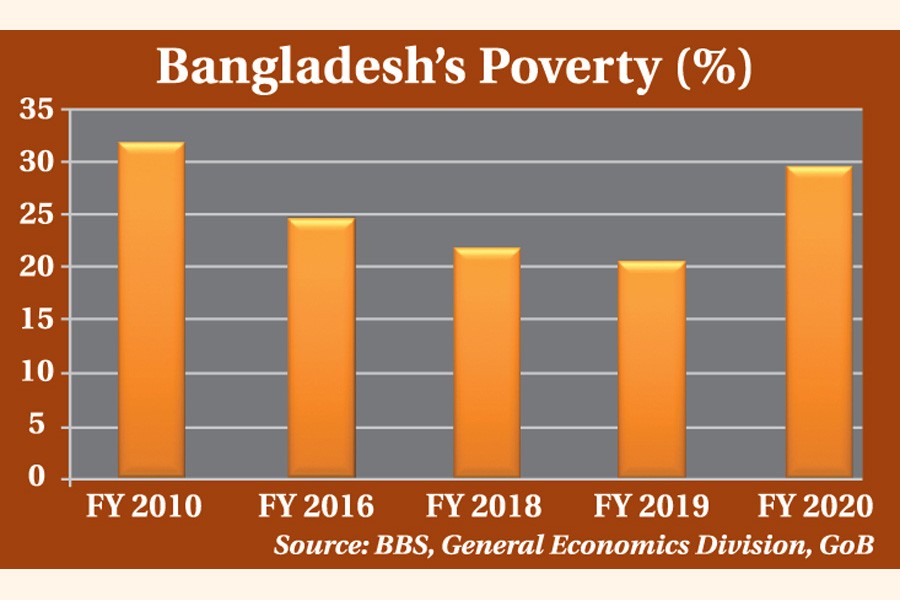
 Bangladesh's poverty rate spiked to 29.4 per cent amid the Covid-19 pandemic from 18.8 per cent estimated before the outbreak of the viral disease, a government report has revealed.
Bangladesh's poverty rate spiked to 29.4 per cent amid the Covid-19 pandemic from 18.8 per cent estimated before the outbreak of the viral disease, a government report has revealed.
The urban areas were worst-affected as the poverty rate jumped to 34.8 per cent, as estimated at the end of the April-June quarter of the last fiscal year, from 15.9 per cent of the previous fiscal year, the General Economics Division (GED) of the Planning Commission has estimated.
The Covid-induced hunger rate in rural areas also rose to 27.4 per cent from 24.4 per cent, it says.
The GED has taken the higher poverty rate as a matter of grave concern in the upcoming 8th Five-Year Plan (FYP) document as the impact of the virus has ravaged the national economy.
"Since the poverty rate has increased and other macroeconomic indicators have also been hit hard, the government would try to facilitate the development work in the next five years for expanding the economy at a higher rate recovering from the losses in three years," GED Member (Senior Secretary) Professor Shamsul Alam said.
He told the FE that they would look to bring down the poverty rate by 6.3 percentage points to 23 per cent within the current fiscal year of FY2021 by applying different financial and economic policies.
In the terminal year (FY2025) of the 8th FYP, they would cut the poverty rate to 15.6 per cent, Dr Alam added.
The GED has already drafted the 8th FYP where it has undertaken the "rapid recovery from COVID-19 to restore human health, confidence, employment, income and economic activities' as the main theme.
The global pandemic has severely affected Bangladesh's economy as millions of people lost their jobs both in formal and informal sectors.
The main backbone of the economy is the informal sector as it has accounted for about 85 per cent of the labour force, employed in the economy, shows the Labour Force Survey of Bangladesh Bureau of Statistics (BBS).
Those working in the informal sector include wage labourers, self-employed persons, unpaid family labour, piece-rate workers, and other hired labour.
Professor Shamsul Alam said: "We have estimated the poverty rate using the forecast method. The people were affected more during the last quarter (Apr-Jun) of the past FY2020 due to the COVID-19 impact."
The informal sector was affected most by the coronavirus pandemic in the country, he told the FE.
Prof Alam said although the poverty rate had spiked due to the COVID impact in the fourth quarter of last FY2020, it now started falling again from the first quarter of the current calendar year 2021 amid the bid to restart the economy.
When asked about the higher poverty estimation by different research organisations, Dr Alam said: "The government had the larger number of samples than any of private research firms. So, the GED's estimation is more realistic than others."
According to BBS data, the poverty rate had declined to 20.5 per cent in the country in the previous FY2019 from 21.8 per cent in FY2018.
The extreme poverty rate had also come down to 10.5 per cent in FY2019 from 11.3 per cent in FY2018.
Local think-tanks including the Centre for Policy Dialogue (CPD), the South Asian Network on Economic Modeling (SANEM), Bangladesh Institute of Development Studies (BIDS) and BRAC had given separate poverty estimations due to the impact of the coronavirus pandemic.
The CPD forecasts showed that the poverty rate would increase to 35 per cent by the end of this year, leading to further inequality.
The SANEM in its estimation said the overall poverty in the country would double to 40.9 per cent as a large number of the less impoverished became 'new poor' following the economic downturn brought about by the coronavirus outbreak in Bangladesh in March.
The BIDS in a research findings forecast that under a post-lockdown optimistic scenario, the country's overall poverty rate would increase to 25.13 per cent.
It further said the poverty rate in rural areas could be 24.23 per cent and in urban areas 27.52 per cent.
The BIDS also projected that Bangladesh would have 16.4 million new poor in 2020 as the incomes of the working class in urban and rural areas fell sharply due to the prolonged lockdown.
The BRAC in a survey in April said since the corona disease broke out in Bangladesh, extreme poverty had risen by 60 per cent while 14 per cent people did not have any food at home.
The GED is its estimation said the COVID hit almost all the macro-economic indicators in Bangladesh.
Before the pandemic, the per capita GNI was preliminary estimated at US$2,173 in the FY2020 which later fell to $2,079 due to the impact of coronavirus during the last quarter (April to June) of the FY2020.
CPD Research Director Dr KG Moazzem said the poverty estimation of the government after the COVID impact is a good gesture. "It will help the government to take necessary measures to tackle the growing poverty due to the coronavirus impact."
However, the 5.24 per cent growth estimation for the last FY2020 did not match the growing poverty rate, he told the FE.
"We hope the government will provide a final GDP growth estimation for the last fiscal with a realistic approach," Dr Moazzem said.
© 2024 - All Rights with The Financial Express
